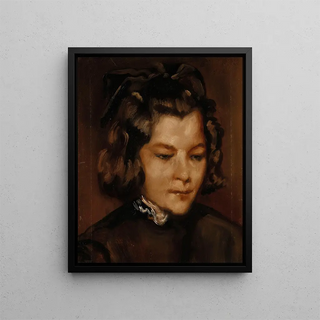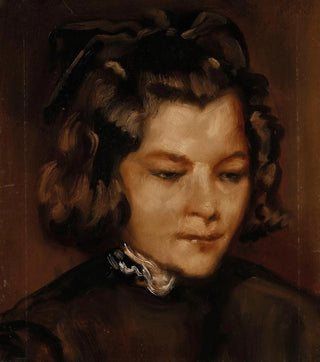Painting Portrait of Aude - Émile Bernard | Art print


View from behind

Frame (optional)
The "Portrait of Aude" by Émile Bernard stands as an iconic artwork, capturing not only the essence of a face but also the soul of an era. This painting, imbued with post-impressionist sensitivity, invites viewers to immerse themselves in a world where vibrant colors and stylized forms come together to tell a story. Aude, model and muse, becomes a timeless figure through this art print, embodying beauty and reflection. Émile Bernard, at the dawn of his career, manages to transcend mere representation to offer a personal and poetic vision of his subject.
Style and uniqueness of the work
Bernard's style is characterized by a bold and innovative approach, blending impressionist influences with a quest for structure and composition. In this art print, Aude's features are rendered with a delicacy that demonstrates a deep respect for feminine beauty. The chosen colors, both warm and luminous, create an intimate, almost dreamlike atmosphere. Every brushstroke seems charged with emotion, revealing not only the physicality of the model but also a part of her inner world. The use of light, subtle and reflective, emphasizes volumes, while the slightly blurred contours evoke a certain softness, a tenderness that envelops the viewer. This painting is much more than a simple portrait; it is an exploration of feelings and thoughts, a true window into the soul of its subject.
The artist and his influence
Émile Bernard, a central figure of the post-impressionist movement, distinguished himself with his unique approach to painting. Trained alongside masters such as Paul Gauguin, he developed a style that is his own, blending traditional techniques with a modern vision. Bernard does not merely apply colors to a canvas; he seeks to express ideas, emotions, and to capture the spirit of his time. His work has influenced many artists, notably through his way of integrating symbolist elements into his artworks. Through "Portrait of Aude," he not only honors his model but also a period when art begins to explore new paths.

Matte finish

View from behind

Frame (optional)
The "Portrait of Aude" by Émile Bernard stands as an iconic artwork, capturing not only the essence of a face but also the soul of an era. This painting, imbued with post-impressionist sensitivity, invites viewers to immerse themselves in a world where vibrant colors and stylized forms come together to tell a story. Aude, model and muse, becomes a timeless figure through this art print, embodying beauty and reflection. Émile Bernard, at the dawn of his career, manages to transcend mere representation to offer a personal and poetic vision of his subject.
Style and uniqueness of the work
Bernard's style is characterized by a bold and innovative approach, blending impressionist influences with a quest for structure and composition. In this art print, Aude's features are rendered with a delicacy that demonstrates a deep respect for feminine beauty. The chosen colors, both warm and luminous, create an intimate, almost dreamlike atmosphere. Every brushstroke seems charged with emotion, revealing not only the physicality of the model but also a part of her inner world. The use of light, subtle and reflective, emphasizes volumes, while the slightly blurred contours evoke a certain softness, a tenderness that envelops the viewer. This painting is much more than a simple portrait; it is an exploration of feelings and thoughts, a true window into the soul of its subject.
The artist and his influence
Émile Bernard, a central figure of the post-impressionist movement, distinguished himself with his unique approach to painting. Trained alongside masters such as Paul Gauguin, he developed a style that is his own, blending traditional techniques with a modern vision. Bernard does not merely apply colors to a canvas; he seeks to express ideas, emotions, and to capture the spirit of his time. His work has influenced many artists, notably through his way of integrating symbolist elements into his artworks. Through "Portrait of Aude," he not only honors his model but also a period when art begins to explore new paths.
12,34 €






